
The Royal Danish Navy is the sea-based branch of the Danish Armed Forces force. The RDN is mainly responsible for maritime defence and maintaining the sovereignty of Danish territorial waters. Other tasks include surveillance, search and rescue, icebreaking, oil spill recovery and prevention as well as contributions to international tasks and forces.

USS Thetis Bay (CVE-90) was the thirty-sixth of fifty Casablanca-class escort carriers built for the United States Navy during World War II. She was launched in March 1944, commissioned in April, and served as a transport carrier in the Pacific, as well as a replenishment carrier supporting the Allied bombardment of Tokyo and the Main Islands. Postwar, she participated in Operation Magic Carpet, before being decommissioned in August 1946, being mothballed in the Pacific Reserve Fleet. She was reactivated in July 1956, and converted to a helicopter transport carrier, serving in relief operations in Taiwan and Haiti. Ultimately, she was broken up in 1966, the last Casablanca-class hull to be scrapped.
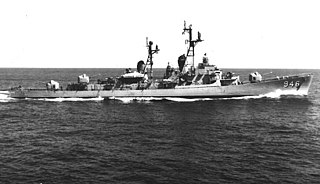
USS Edson (DD-946) is a Forrest Sherman-class destroyer, formerly of the United States Navy, built by Bath Iron Works in Maine in 1958. Her home port was Long Beach, California and she initially served in the Western Pacific/Far East, operating particularly in the Taiwan Strait and off the coast of Vietnam. Her exceptionally meritorious service in 1964 in the Gulf of Tonkin was recognized with the first of three Navy Unit Commendations. During the following years she was shelled by North Vietnamese land forces, and apparently received friendly fire from the US Air Force.
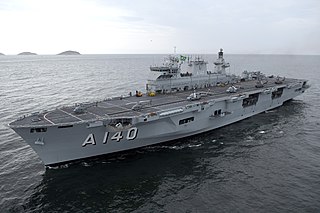
Landing platform helicopter (LPH) is a term used by some navies to denote a type of amphibious warfare ship designed primarily to operate as a launch and recovery platform for helicopters and other VTOL aircraft. As such, they are considered a type of helicopter carrier.

HMS Thetis (N25) was a Group 1 T-class submarine of the Royal Navy which sank during sea trials in Liverpool Bay, England on 1 June 1939. After being salvaged and repaired, the boat was recommissioned as HMS Thunderbolt in 1940. It served during the Second World War until being lost with all hands in the Mediterranean on 14 March 1943.
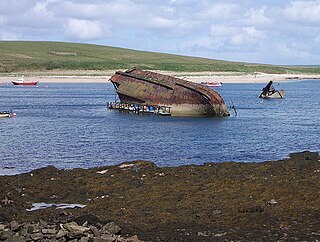
A blockship is a ship deliberately sunk to prevent a river, channel, or canal from being used as a waterway. It may either be sunk by a navy defending the waterway to prevent the ingress of attacking enemy forces, as in the case of HMS Hood at Portland Harbour in 1914; or it may be brought by enemy raiders and used to prevent the waterway from being used by the defending forces, as in the case of the three old cruisers HMS Thetis, Iphigenia and Intrepid scuttled during the Zeebrugge raid in 1918 to prevent the port from being used by the German navy.

USS LST-325 is a decommissioned tank landing ship of the United States Navy, now docked in Evansville, Indiana, US. Like many of her class, she was not named and is properly referred to by her hull designation.
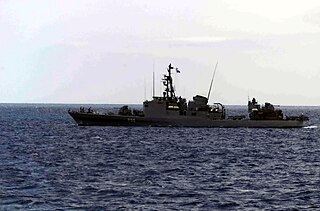
The Thetis-class gunboats was a class of five naval ships of the Hellenic Navy, originally developed for the German Navy as Class 420 and first commissioned in 1961.
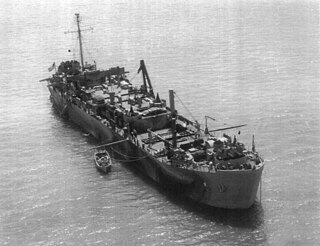
USS Endymion (ARL-9) was one of 39 Achelous-class landing craft repair ships built for the United States Navy during World War II. Named for Endymion, she was the only U.S. Naval vessel to bear the name.

USS Acubens (AKS-5) was an Acubens-class general stores issue ship commissioned by the U.S. Navy for service in World War II, named after the star Acubens, the alpha star in Cancer. She was responsible for delivering and disbursing goods and equipment to locations in the war zone.

USS Disdain (AM-222) was an Admirable-class minesweeper built for the United States Navy during World War II and in commission from 1944 to 1945. She was transferred to the Soviet Union in 1945 and after that served in the Soviet Navy as T-271.

USCGC Icarus (WPC-110) was a steel-hulled, diesel-powered Thetis-class patrol boat of the United States Coast Guard that patrolled the United States East Coast during World War II. In 1942, Icarus sank the German submarine U-352 off the coast of North Carolina and took its survivors into custody as prisoners of war. U-352 was the second World War II U-boat sunk by the United States in American waters, and the first one from which survivors were taken.

The third USS Calypso (AG-35) was launched 6 January 1932 for the United States Coast Guard as USCGC Calypso (WPC-104) by the Bath Iron Works in Bath, Maine. She was initially stationed at San Diego, California, and transferred to Baltimore, Maryland in 1938. She was transferred from the Coast Guard to the U.S. Navy on 17 May 1941 and commissioned the same day.
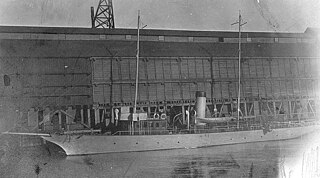
The second USS Thetis (SP-391) was a United States Navy patrol vessel in commission from 1917 to 1919.

SMS Thetis was the fourth member of the ten-ship Gazelle class of light cruisers that were built for the German Kaiserliche Marine in the late 1890s and early 1900s. The Gazelle class was the culmination of earlier unprotected cruiser and aviso designs, combining the best aspects of both types in what became the progenitor of all future light cruisers of the Imperial fleet. Built to be able to serve with the main German fleet and as a colonial cruiser, she was armed with a battery of ten 10.5 cm (4.1 in) guns and a top speed of 21.5 knots.
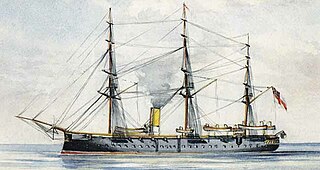
HMS Thetis was a Briton-class wooden screw corvette built for the Royal Navy in the late 1860s.
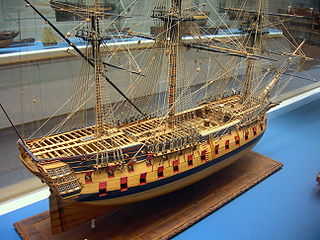
The action of 17 July 1761 was a naval engagement fought off the Spanish port of Cádiz between a British Royal Navy squadron and a smaller French Navy squadron during the Seven Years' War. British fleets had achieved dominance in European waters over the French following heavy defeats of French fleets in 1759. To maintain this control, British battle squadrons were stationed off French ports, as well as ports in neutral but French-supporting Spain which sheltered French warships. In 1761, two French ships, the 64-gun ship of the line Achille and 32-gun frigate Bouffone were blockaded in the principal Spanish naval base of Cádiz, on the Southern Atlantic coast of Spain.

USS Snohomish County (LST-1126) was an LST-542-class tank landing ship built for the United States Navy during World War II. Named after Snohomish County, Washington, she was the only U.S. naval vessel to bear the name.

















